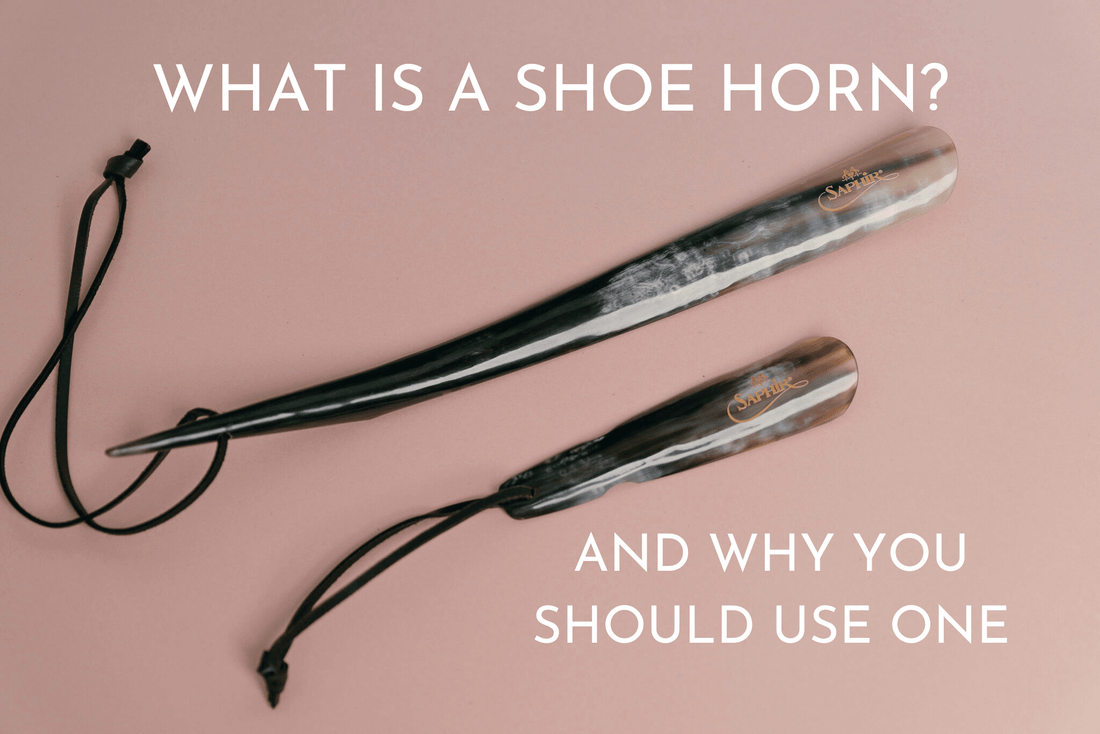Shoe horns are a very underrated tool in the realm of shoe care. They are much more than something you get at the customer service desk at your favourite store.
We're going to dive into why you should be using a shoe horn and why it is an asset to have.
First, let's discuss a little bit about what a shoe horn is.
What Is A Shoe Horn?
Shoe horns come by a few different names. They're sometimes referred to as shoe horn, shoehorn, or shoe spoon depending on who you ask.
They consist of a handle to grip and a then elongate into a thin flat portion. This flat portion is meant to help glide your foot into a snug fitting shoe with ease.
They also come in different lengths. Shorter handed ones are convenient for travel or keeping at the office. Their size is better suited for storage in a bag or purse.
A long handled shoe horn allows you to put on your footwear with less bending. Thus the extra long shoe horn is great to keep in the closet or near your entrance. A long shoe horn is a preference for users who have difficulty bending over.

A close up of the horn texture. Note the beautiful natural variation in the material. Each one is unique.
Shoe horns were originally made from natural animal horn. Animal horn was selected for its strength and beauty. Admirable product features.
Shoe horns date back to the 15th century so natural materials were cutting edge at that time! If you're looking for a timeless gift for someone, a quality natural horn shoe horn is a wonderful option.
We stock do different options from Saphir Medaille d'Or in natural horn. One longer and one shorter. They are as well made as they are beautiful.

A photo displaying the natural horn shoehorns mentioned above. Sizes added for ease of comparison.
Shoe horns are now made out of all types of materials. You will see shoe horns made out of plastic and wood. A metal shoe horn is another popular choice since it is such a strong and flexible material. All types of metals can be seen, from brass to aluminum.
We also offer an inexpensive and lightweight plastic option from Saphir. Wonderful to keep a few around anywhere you find yourself putting on footwear.
How Is A Shoe Horn Part Of Shoe Care? Why Should I Use One?
A shoe horn makes putting your shoes on much easier. Of course.
It also provides some protection to both you and your shoe.
Firstly, I'm sure you've seen individuals try and cram their foot into their shoe. Squeezing and crushing their fingers in the process...we've been there ourselves.
A shoe horn provides a smooth surface to glide your foot into your shoe. This becomes even more apparent if you aren't wearing a sock.
We feel this is reason enough to purchase a shoe horn.

A close up displaying our Saphir plastic shoe horn. Pictured in the top right in yellow and blue. A wonderful choice for something more economical.
Secondly, leather dress shoes usually have a heel counter. That means that the heel of your shoe has a firm structured portion built into it. In order to give the heel shape, it is inserted into the shoe when it is being made. Sometimes it is plastic or hardened leather.
It isn't connected to the inner sole or the welt of the shoe, it is normally self sustaining.
Given how it is placed, it can be damaged if stepped on. In other words if are having to stomp your foot into your shoe you are likely damaging the heel counter. This heel counter cannot easily be repaired. Once damaged there is no going back.
You'd be forced to shell out some big repair costs of opening up the entire shoe. Sometimes this is impossible. Sometimes it might involve shipping your shoe back to the original manufacturer. Best if avoided all together.
If you're still reading, hopefully you're convinced on the merits of using a shoe horn.
How To Use A Shoe Horn
Using a shoe horn is extremely simple.

A shot of some proper technique before your place your foot in. The logo goes to the back of the shoe. The "scoop" side goes against your heel.
Hold the horn in your hand. Begin to place your foot into your shoe until your foot is about half way into your shoe.
Take the shoe horn and place the open side (concave side or fatter side) on the opening of the heel of the shoe.
As you begin to slide your foot in you should notice your heel make contact with the shoe horn. Guide your foot in and voila. That's it. It works the same way you might use your finger: by keeping the opening or the "mouth" of the shoe open for your foot. This method is pain free.
You can use a shoe tree with almost any type of shoe. They are especially helpful with loafers and snug shoes. We use them with sneakers as well.
If you're not sure which one to get starting with an plastic one is a good idea. I keep several at the front entrance as they always seem to get misplaced.
A natural horn in your desired length can be an heirloom item that your children will inherit. If you use them regularly and want to treat yourself to something nice, look no further.
If you're looking for additional information about shoe care, check out some of our other blog posts.
In the meantime, thanks for reading.


2 comments
Natalie,
Shoe trees are an essential element of shoe care. They greatly increase the life of shoes by reducing excess moisture and minimizing creases.
You can find out more about Shoe Trees on our blog below:
https://brillare.ca/blogs/blog/shoetrees
What is a shoe tree